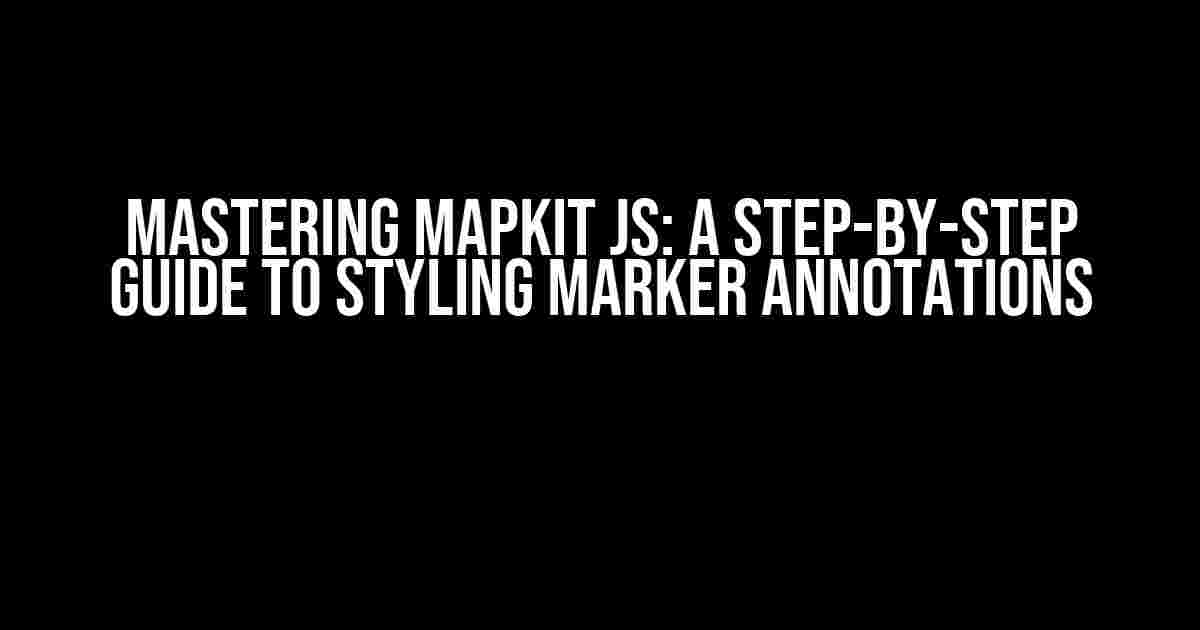Are you tired of boring, default markers on your MapKit JS maps? Do you want to add a touch of personality and brand identity to your map annotations? You’re in the right place! In this comprehensive guide, we’ll dive into the world of MapKit JS marker styling, covering everything from the basics to advanced techniques. By the end of this article, you’ll be a master of customizing marker annotations and taking your map visualization to the next level.
Why Style Marker Annotations?
Before we dive into the nitty-gritty of styling, let’s cover why it’s essential to customize your marker annotations. Here are just a few reasons:
- Branding consistency**: Match your map’s visual style to your brand’s identity and maintain a consistent look across all platforms.
- Improved user experience**: Differentiate between various types of markers, making it easier for users to understand the context and purpose of each annotation.
- Enhanced visualization**: Add visual interest to your map by using diverse shapes, colors, and icons, making it more engaging and interactive.
Prerequisites and Setup
Before we start styling, make sure you have the following set up:
- A MapKit JS map instance with a valid Apple developer account and API key.
- A basic understanding of JavaScript, HTML, and CSS.
- A code editor or IDE of your choice (e.g., Visual Studio Code, Sublime Text, or Atom).
Understanding Marker Annotations in MapKit JS
In MapKit JS, marker annotations are represented by the `MKMarkerAnnotation` class. When you create a marker, you can customize its appearance using the following properties:
| Property | Description |
|---|---|
glyphText |
Specifies the text to display inside the marker. |
glyphImage |
Specifies the image to use as the marker icon. |
color |
Specifies the marker’s fill color. |
strokeColor |
Specifies the marker’s stroke color. |
strokeWidth |
Specifies the marker’s stroke width. |
Styling Marker Annotations: Basic Customization
Let’s start with basic customization using the `glyphText` and `color` properties.
// Create a new marker annotation
const marker = new MKMarkerAnnotation({
location: new MKMapPoint(37.7749, -122.4194),
glyphText: 'Hello, World!',
color: 'blue'
});
// Add the marker to the map
map.addAnnotation(marker);
In this example, we created a new marker with the text “Hello, World!” and a blue fill color.
Styling Marker Annotations: Advanced Customization
Now, let’s explore more advanced customization techniques using the `glyphImage` property and CSS.
Using Custom Icon Images
Replace the default marker icon with a custom image:
// Create a new marker annotation with a custom icon
const marker = new MKMarkerAnnotation({
location: new MKMapPoint(37.7749, -122.4194),
glyphImage: 'https://example.com/custom-icon.png'
});
// Add the marker to the map
map.addAnnotation(marker);
In this example, we specified a custom icon image URL using the `glyphImage` property.
Styling Markers with CSS
Apply CSS styles to your markers using the `glyphText` property and CSS selectors:
// Create a new marker annotation with a custom CSS class
const marker = new MKMarkerAnnotation({
location: new MKMapPoint(37.7749, -122.4194),
glyphText: 'Hello, World!'
});
// Add the marker to the map
map.addAnnotation(marker);
In this example, we wrapped the marker text in a `` element with a custom CSS class `custom-marker`. You can then target this class in your CSS file:
/* style.css */
.custom-marker {
font-size: 14px;
font-weight: bold;
color: #fff;
background-color: #333;
padding: 4px 8px;
border-radius: 50%;
}
In this example, we applied custom styles to the marker text using the `.custom-marker` class.
Best Practices and Tips
Here are some best practices and tips to keep in mind when styling marker annotations:
- Keep it consistent**: Establish a consistent visual style across all markers to maintain a professional and cohesive look.
- Use meaningful iconography**: Choose icons that effectively represent the data or concept they’re associated with.
- Test for accessibility**: Ensure your custom styles are accessible and readable for users with disabilities.
- Optimize for performance**: Use optimized images and keep your CSS concise to avoid performance degradation.
Conclusion
With these comprehensive guides and examples, you’re now equipped to style your MapKit JS marker annotations like a pro! Remember to keep it consistent, accessible, and optimized for performance. Don’t be afraid to experiment and push the boundaries of what’s possible with custom marker styling.
Need more help or have questions? Check out the official MapKit JS documentation and community forums for additional resources and support.
Happy mapping!
Here are 5 questions and answers about styling a MapKit JS marker annotation:
Frequently Asked Questions
Get ready to take your map game to the next level with these styling tips for MapKit JS marker annotations!
1. Can I change the color of my marker annotation?
Yes, you can! To change the color of your marker annotation, you can use the `tintColor` property in your marker annotation’s options. For example, `marker.annotation.options.tintColor = ‘blue’;` will give your marker a blue tint.
2. How do I add an image to my marker annotation?
Easy peasy! To add an image to your marker annotation, you can use the `image` property in your marker annotation’s options. For example, `marker.annotation.options.image = ‘myImage.png’;` will display the image `myImage.png` on your marker.
3. Can I customize the size of my marker annotation?
Absolutely! You can adjust the size of your marker annotation using the `size` property in your marker annotation’s options. For example, `marker.annotation.options.size = new MKAnnotationView.Size(40, 40);` will set the size of your marker to 40×40 pixels.
4. How do I add a callout to my marker annotation?
To add a callout to your marker annotation, you can use the `canShowCallout` property in your marker annotation’s options and set it to `true`. You can then customize the callout’s appearance and behavior using other properties, such as `calloutOffset` and `rightCalloutAccessoryView`.
5. Can I animate my marker annotation?
Yes, you can! MapKit JS provides several animation options for marker annotations, such as `animatedDrop` and `animatedMove`. You can use these animations to create a more engaging user experience and draw attention to specific locations on your map.
Let me know if you need any further assistance!




